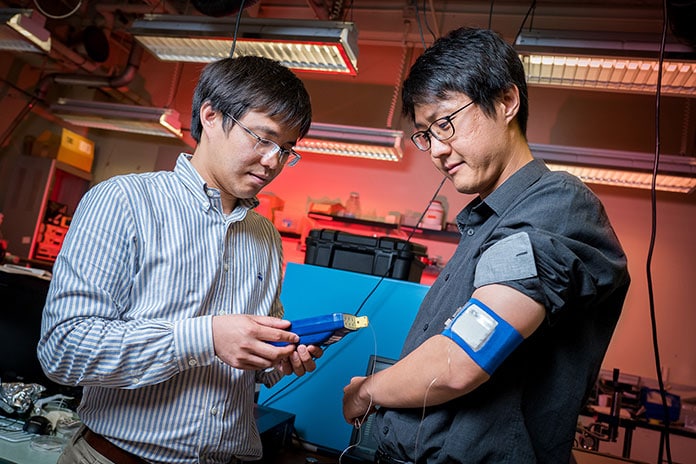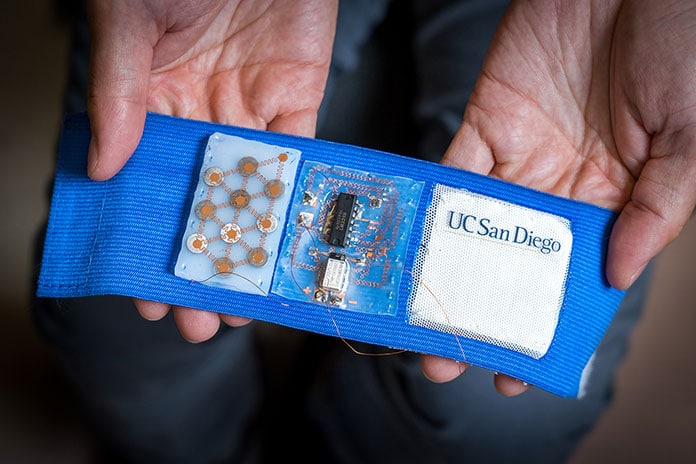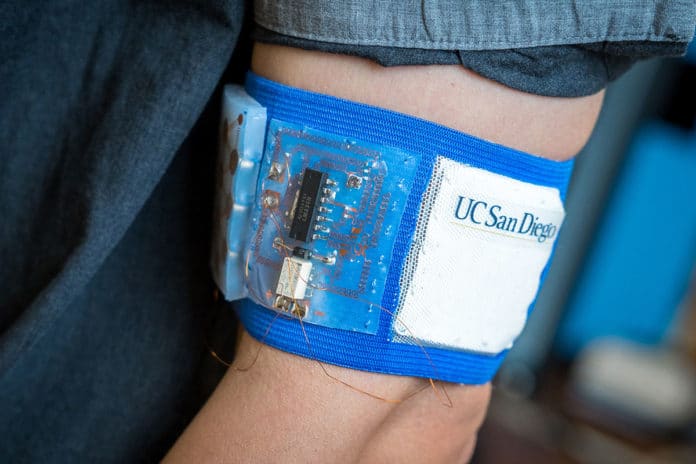There are a variety of personal cooling and heating devices available in the market, but they are not so convenient to wear and carry around. Here is a new portable device that could be the perfect solution for this.
The engineers at the University of California San Diego have successfully developed a wearable patch that can cool down or warm up the wearer at home, work, or on the go. It is an armband patch that works as a ‘personal thermostat.’ This soft, stretchy patch cools or warms a user’s skin to a comfortable temperature and keeps it there as the ambient temperature changes.
The patch works for more than eight hours and can lower someone’s skin temperature by up to 10C (50F). The new wearable device is designed to be more comfortable and convenient to wear. It is flexible, lightweight, and can be easily implanted into clothing.
The personal thermostat works using thermoelectric alloys- materials that use electricity to create a temperature difference and vice versa, that are sandwiched between the heat-conducting stretchy sheets. The patch is powered by a flexible battery pack. The device physically cools or heats the skin to a temperature that the wearer chooses.
“This type of device can improve your personal thermal comfort whether you are commuting on a hot day or feeling too cold in your office,” said Professor Renkun Chen, who led the study.

“You could place this on spots that tend to warm up or cool down faster than the rest of the body, such as the back, neck, feet or arms, in order to stay comfortable when it gets too hot or cold,” said first author Sahngki Hong, who worked on the project as a PhD student in Chen’s lab.
The researchers built the patch by taking small pillars of thermoelectric materials (made of bismuth telluride alloys). These pillars are soldered into thin copper electrode strips and sandwiched between two elastomer sheets which are specially engineered to conduct heat while being soft and stretchy.
An electric current from the battery moves across the pillars, driving heat from one sheet to another. If the current flows across the pillars, it drives heat along with it, which causes one side of the patch to heat up and the other to cool down.
The team embedded a prototype of the wearable patch into a mesh armband and tested it on a male subject. Tests were performed in a temperature-controlled environment. In two minutes, the patch cooled the tester’s skin to a set temperature of 89.6 degrees Fahrenheit. It kept the tester’s skin at that temperature as the ambient temperature varied between 71.6 and 96.8 degrees Fahrenheit.

“To do the cooling, we have the current pump heat from the skin side to the layer facing outside,” Chen explained. “To do heating, we just reverse the current so heat pumps in the other direction.“
Moreover, the square-shaped thermostat patch measures 5 × 5 centimeters and uses up to 0.2 watts of power. While the team also estimates that creating a cooling vest would take 144 patches. This would use about 26 watts to keep an individual cool on an average hot day (during extreme heat, estimated power use would climb up to 80 watts, which is about how much a laptop uses). Whereas, a conventional air conditioning system uses tens of kilowatts to cool down an entire office.
Researchers noted that the wearable patch is also more efficient in cooling an individual than a large room. “If there are just a handful of occupants in that room, you are essentially consuming thousands of watts per person for cooling. A device like a patch could drastically cut down on cooling bills,” Chen said.
The study is published in the journal Science Advances. The team is now working on patches that could be built into a prototype cooling and heating vest. They hope to commercialize the technology in a few years.
Journal Reference
- Sahngki Hong et al., Wearable thermoelectrics for personalized thermoregulation. Science Advances. 5, eaaw0536 (2019). DOI:10.1126/sciadv.aaw0536

